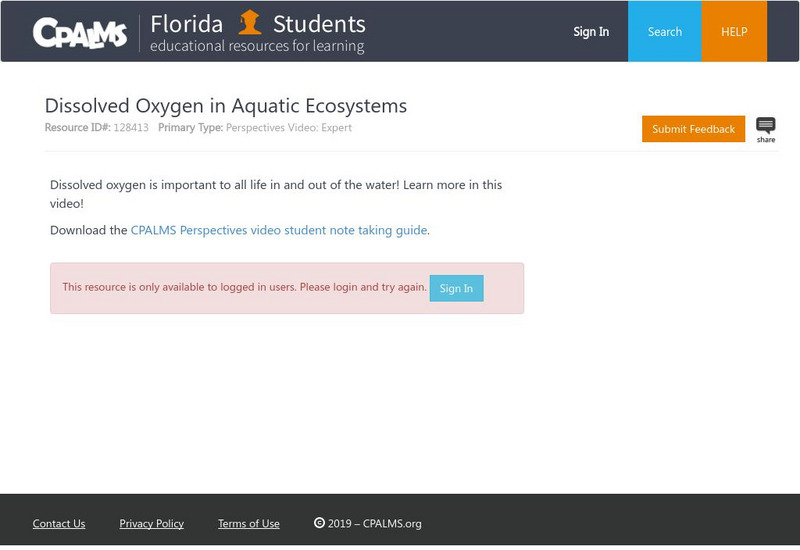PBS
That Time The Ocean Lost (Almost) All Its Oxygen
This is the story of how our planet rescued itself from extreme conditions in the Cretaceous Period, at the cost of essentially suffocating the oceans for half-a-million years.
TED Talks
Natalie Jeremijenko: The art of the eco-mindshift
Natalie Jeremijenko's unusual lab puts art to work, and addresses environmental woes by combining engineering know-how with public art and a team of volunteers. These real-life experiments include: Walking tadpoles, texting "fish,"...
Bozeman Science
AP Biology Lab 12: Dissolved Oxygen
Mr. Andersen demonstrates the azide-winkler method of dissolved oxygen analysis.
SciShow
Could Complex Life Survive on Mars - SciShow News
The water on Mars probably doesn't have much oxygen, but new models show that life doesn't need as much O2 as we thought. And NASA is sending a claw machine to the red planet!
Crash Course
Preventing Flint - Environmental Engineering: Crash Course Engineering #29
A lot of work goes into managing our impact on the environment and its impact on us. That work is the work of environmental engineers. In this episode we’ll explore water quality, air quality, noise pollution, waste management, and more.
Professor Dave Explains
The Aquatic Environment: Marine and Freshwater
Water covers 70% of the surface of the Earth, and serves as home to an incredible variety of living organisms. Most of that water is salty, or marine, while some is freshwater, and it is in constant motion through the hydrologic cycle....
Curated Video
Introduction to Fish Farming
The video is a lecture presentation on fish farming. It discusses why fish is a good source of protein and nutrients for humans and other animals, as well as how fish farming helps conserve wild fish stocks. The video also talks about...
msvgo
Water pollution
It explains causes for water pollution, international standards for drinking water, biomagnification, eutrophication.
EarthEcho International
How to Measure Dissolved Oxygen
ENGAGE: Join Ashlan Gorse Cousteau and students from Earth Force in Alexandria, VA as they measure dissolved oxygen at Four Mile Run Creek. Learn how to use PASCO instruments to record quantitative results for DO as a measure of water...
FuseSchool
Haber Process - environmental and social considerations
Haber Process - environmental and social considerations | Chemistry | FuseSchool
National Parks Service
Acadia National Park - Floating Classroom: Good Data
These videos compliment the variety of water quality programs that occur in Acadia National Park. For teachers looking for good background information on water quality or those looking to attend the Floating Classroom field trip, this...
National Parks Service
Acadia National Park - Floating Classroom: Graphing
These videos compliment the variety of water quality programs that occur in Acadia National Park. For teachers looking for good background information on water quality or those looking to attend the Floating Classroom field trip, this...
Curated Video
Water Treatment: Making Water Safe for Human Consumption
This video presents a lecture on water treatment, specifically on the processes involved in making water extracted from lakes and rivers fit for human consumption. The speaker discusses the different compounds and elements that might be...
FuseSchool
The Haber Process & Its Environmental Implications
Learn the basics about the Haber Process and its environmental implications.
msvgo
Microbes in Sewage Treatment
It describes the role of microbes in sewage treatment plant. It also explains the steps of waste water treatment
PBS
From the Cambrian Explosion to the Great Dying
Life before the dinosaurs was pretty amazing—and very fragile! Discover what Earth was like for Cambrian creatures, from the smallest ocean-dwellers to the first land animals. A video from an extensive biology playlist explores how early...
Fuse School
How The Atmosphere Changed
Has Earth's atmosphere always been capable of supporting life? Discover how the air around us has evolved in the first video in a series of seven. Learners watch the amazing transformations that occurred within the atmosphere...
Fuse School
Environmental Impacts of Detergents
Dangerous detergents? Who knew? Pupils learn of the darker side of laundry day as they complete the series of seven videos on water and the environment. The video shows common detergent ingredients, how these ingredients can harm the...
Bozeman Science
Respiratory System
When at rest, humans exhale about 17.5 ml of water per hour, but they lose about four times that amount during exercise. The video shows learners how worms, insects, fish and humans all respire very differently. Viewers then explore the...
CPALMS
Florida State University Cpalms: Florida Students: Dissolved Oxygen in Aquatic Ecosystems
Why is dissolved oxygen important to life in water? A video will dive into the answer to this question. [5:18]
NOAA
Noaa: Estuary Education: Urban Estuaries: Water Quality Testing
Students measure water quality in the NY-NJ Estuary using simple tools. Scientists explain the importance of good water quality and talk about what causes water quality declines. [5:44]
NOAA
Noaa: Estuary Education: Water Quality Specifics: Measuring Nitrogen
See how students use classroom tools to measure estuarine water quality. Students sample estuary water for nitrogen using the Colorimeter. [3:03]
NOAA
Noaa: Estuary Education: Water Quality Specifics: Using a Hydrometer
Learn how students can use classroom tools to measure estuarine water quality. Students sample ocean, estuary and tap water for salinity using the Hydrometer. [5:09]
NOAA
Noaa: Estuary Education: Water Quality Specifics: Using a Colorimeter
Watch students use classroom tools to measure estuarine water quality. Students sample estuary water for salinity and dissolved oxygen using a low-end colorimeter. [2:21]









